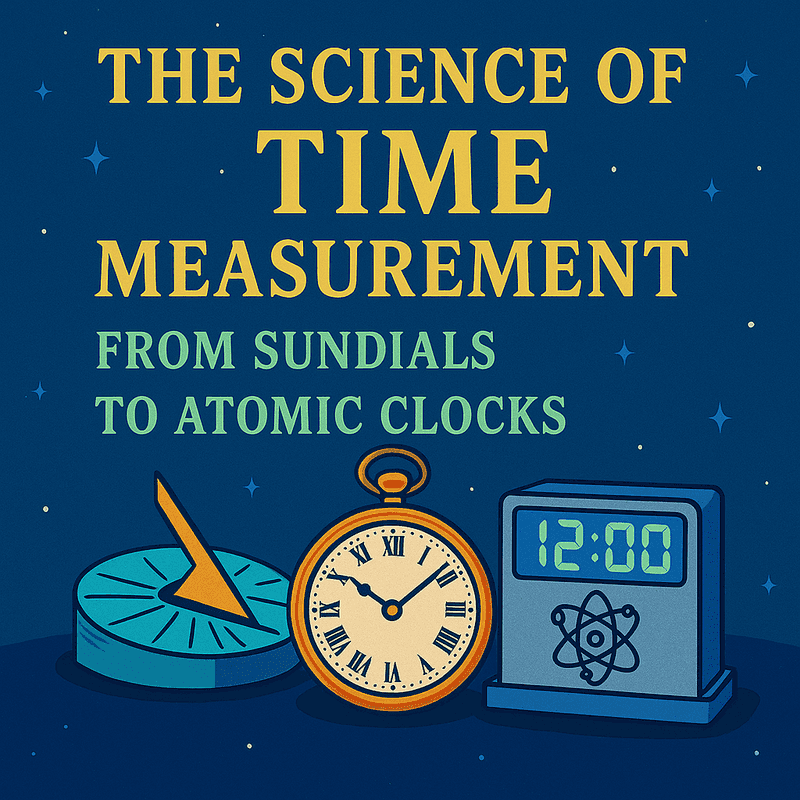
Time measurement stands as one of humanity's most fundamental and challenging scientific endeavors. From the earliest civilizations to the modern era, our ability to measure time with increasing precision has transformed not only science and technology but also the very fabric of human society. The journey from simple sundials to atomic clocks represents one of the most remarkable technological evolutions in human history.
The earliest time-measuring devices relied on natural phenomena that were visible and predictable. The sundial , perhaps the oldest timekeeping device, uses the position of the Sun's shadow to indicate time. Ancient Egyptians, Greeks, and Chinese all developed sophisticated sundials that could measure time with remarkable accuracy for their era. These devices worked by casting a shadow from a gnomon (a vertical rod or pillar) onto a marked surface, with the shadow's position indicating the time of day.
However, sundials had significant limitations. They only worked during daylight hours and were affected by weather conditions. More importantly, they measured apparent solar time, which varies throughout the year due to the Earth's elliptical orbit and axial tilt. This variation, known as the equation of time, can cause sundial time to differ from clock time by up to 16 minutes.
To address these limitations, ancient civilizations developed water clocks, or clepsydras . These devices measured time by the regulated flow of water from one container to another. Water clocks could operate continuously, regardless of weather or time of day, making them more reliable than sundials for many applications.
The development of mechanical clocks in medieval Europe marked a revolutionary advance in time measurement. These early clocks used various mechanisms— including verge and foliot escapements, and later pendulum systems—to regulate the movement of gears and provide consistent time intervals. The pendulum clock, developed by Christiaan Huygens in 1656, was particularly significant because it provided unprecedented accuracy for its time.
The pendulum clock's accuracy was based on a fundamental principle of physics: the period of a pendulum's swing depends primarily on its length and the acceleration due to gravity, not on the amplitude of the swing (for small angles). This property, known as isochronism, made pendulum clocks much more accurate than previous mechanical timekeepers.
However, even the most precise pendulum clocks were limited by environmental factors such as temperature changes (which affect the pendulum's length) and variations in local gravity. These limitations became increasingly problematic as scientific and technological needs demanded ever greater precision.
The 20th century brought revolutionary advances in time measurement with the development of electronic and atomic clocks. The National Bureau of Standards (now the National Institute of Standards and Technology) in the United States developed the first atomic clock in 1949, using the ammonia molecule as the frequency reference.
The breakthrough came with the development of the cesium atomic clock in 1955. Cesium atomic clocks use the hyperfine transition of cesium-133 atoms as their frequency reference. When cesium atoms are exposed to microwave radiation at exactly 9,192,631,770 cycles per second, they undergo a transition between two energy states. This frequency is so stable that it has been used to define the second in the International System of Units since 1967.
The precision of atomic clocks is extraordinary. Modern cesium atomic clocks can keep time with an accuracy of about one second in 100 million years. This level of precision has enabled countless technological advances, from GPS navigation to telecommunications to fundamental physics research.
The development of even more precise time standards continues today. Optical atomic clocks, which use visible light rather than microwave radiation, offer the potential for even greater precision. These clocks use atoms or ions that have optical transitions with frequencies around 10^15 Hz, compared to the 10^10 Hz frequencies used in microwave atomic clocks.
The impact of precise time measurement extends far beyond the laboratory. GPS navigation systems rely on extremely accurate timing to determine positions. Each GPS satellite carries multiple atomic clocks, and the system's accuracy depends on maintaining precise synchronization between these clocks and ground stations.
Telecommunications networks also depend on precise timing for data transmission and synchronization. Modern digital communications require precise timing to ensure that data packets arrive at their destinations in the correct order and at the right time.
In scientific research, precise time measurement enables experiments that would be impossible otherwise. For example, the detection of gravitational waves by the LIGO observatory requires timing measurements with precision of one part in 10^21—equivalent to measuring the distance to the nearest star to within the width of a human hair.
The quest for ever more precise time measurement continues to drive technological innovation. Researchers are developing clocks based on individual trapped ions, optical lattice clocks using thousands of atoms, and even clocks based on nuclear transitions rather than atomic transitions.
These advances in time measurement have profound implications for our understanding of the universe. Precise timing measurements have confirmed predictions of Einstein's theory of general relativity, including the slowing of time in strong gravitational fields and the effects of relative motion on time.
The story of time measurement is more than just a technical history—it's a testament to human ingenuity and our relentless pursuit of precision and understanding. From simple sundials to atomic clocks, each advance in time measurement has opened new possibilities for science, technology, and human society.
As we continue to develop ever more precise time standards, we are not just improving our ability to measure time—we are expanding our understanding of the fundamental nature of reality itself. The precision of modern time measurement has become a tool for exploring the deepest mysteries of the universe, from the behavior of fundamental particles to the structure of spacetime itself.